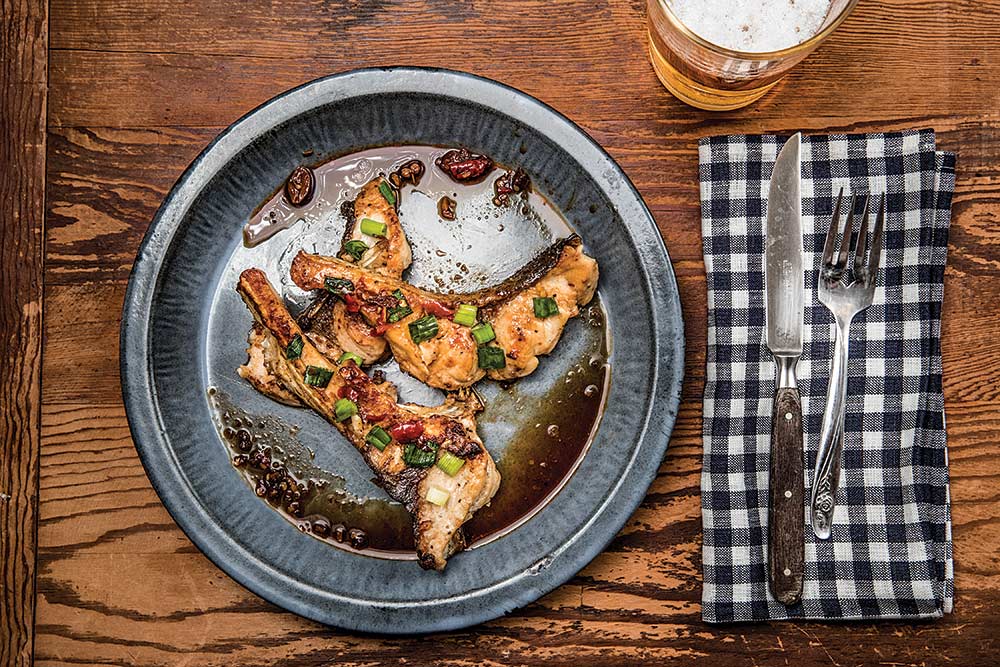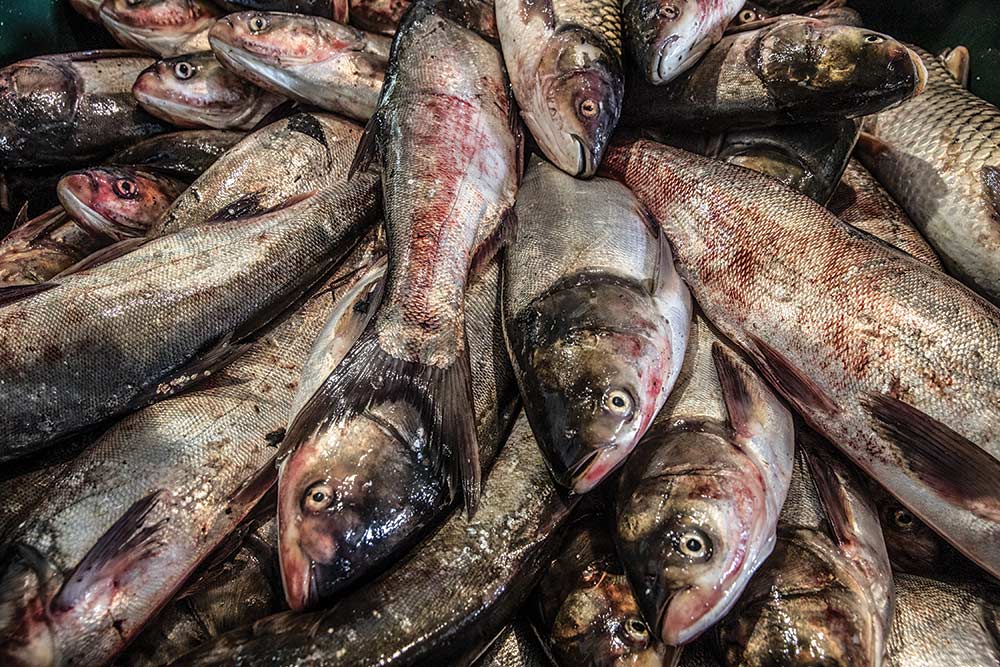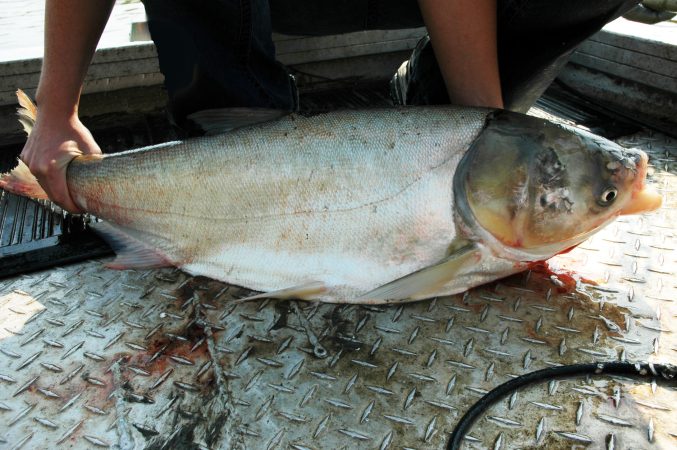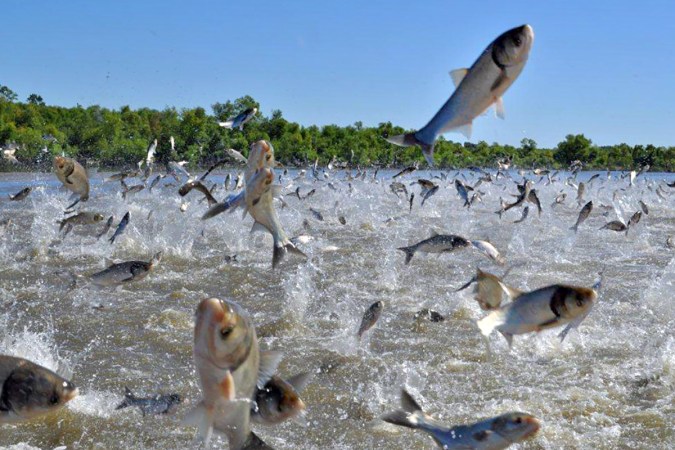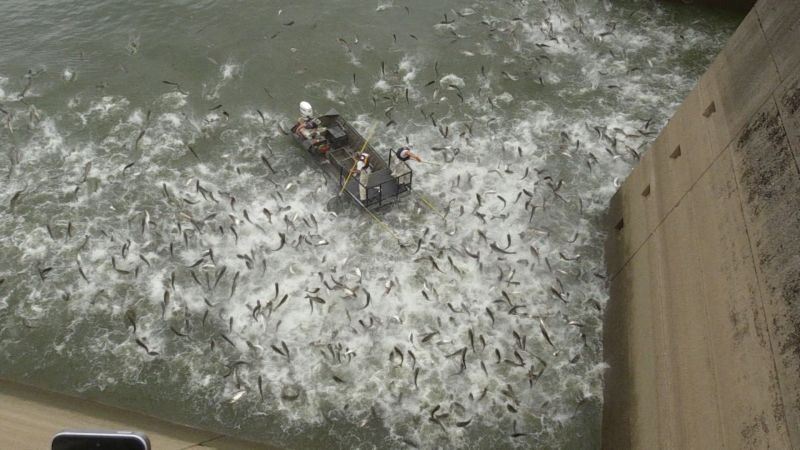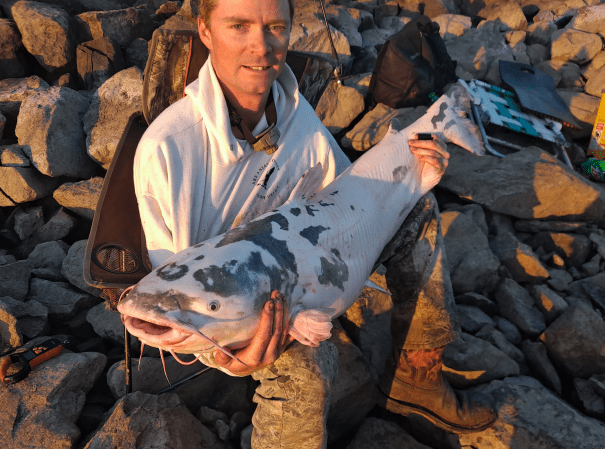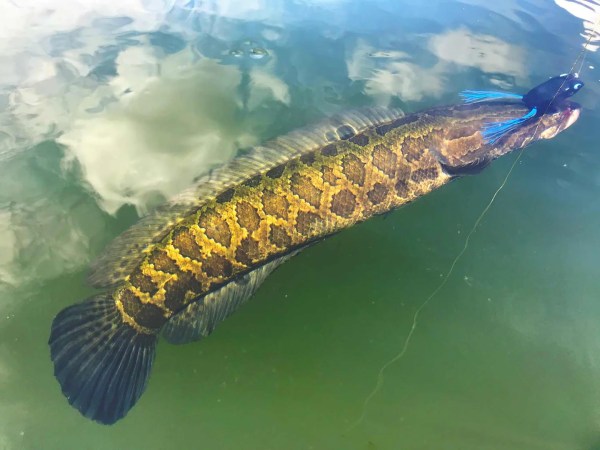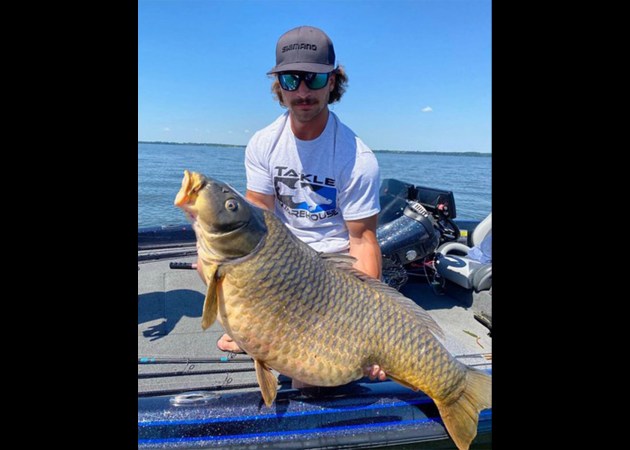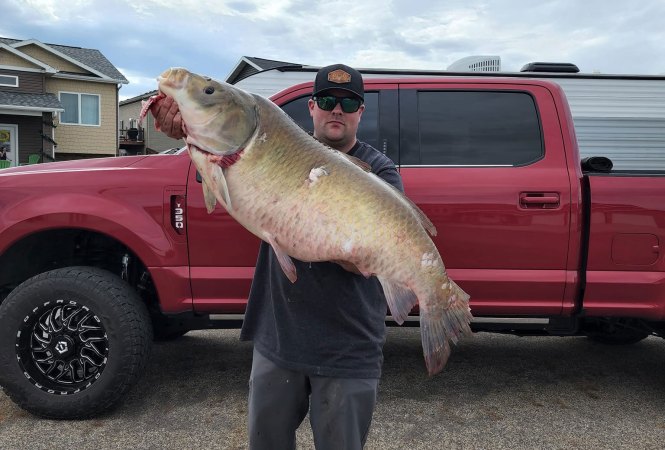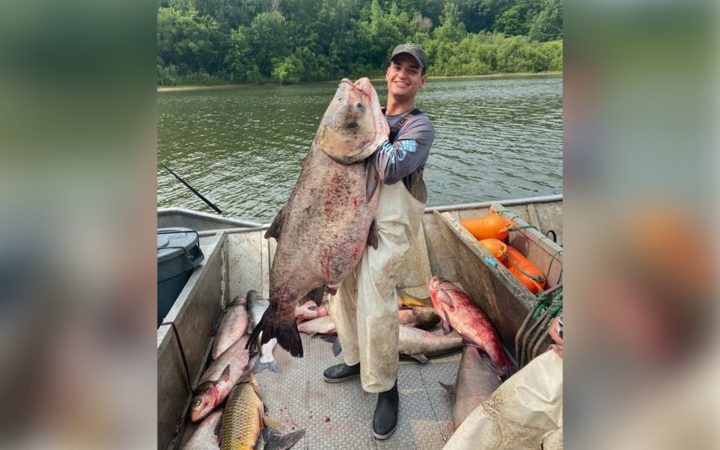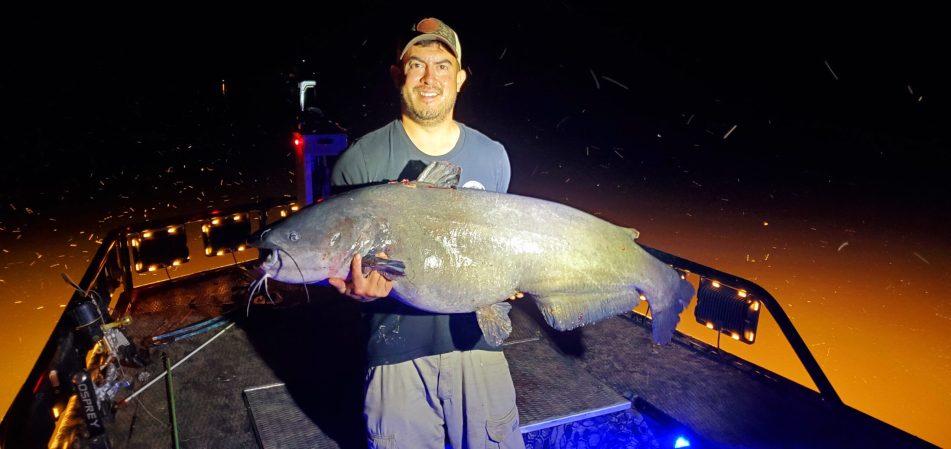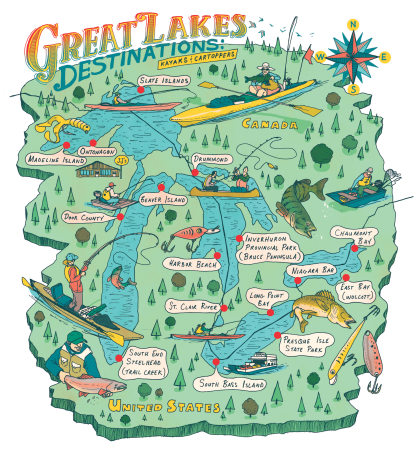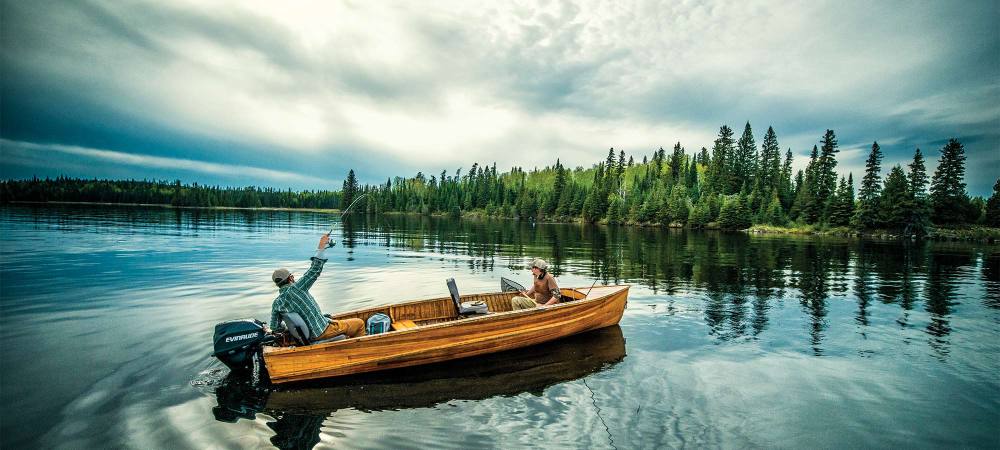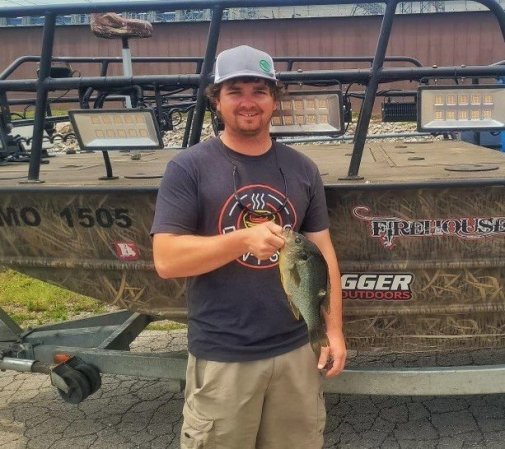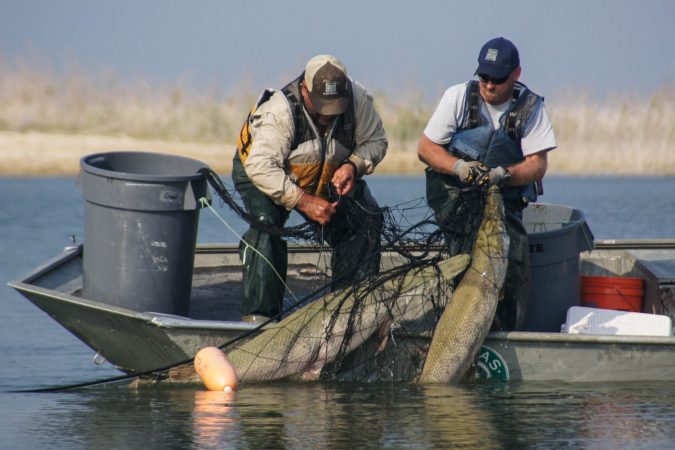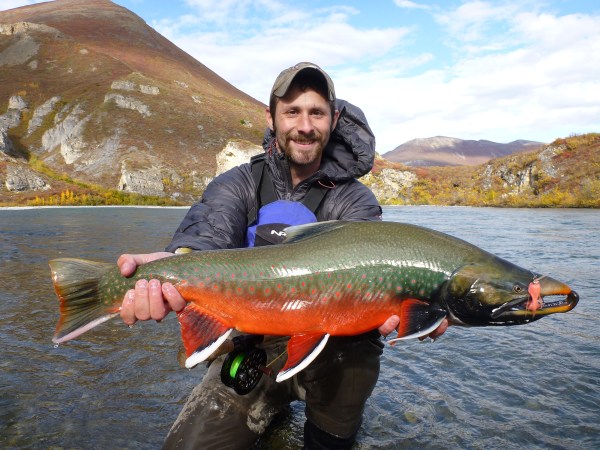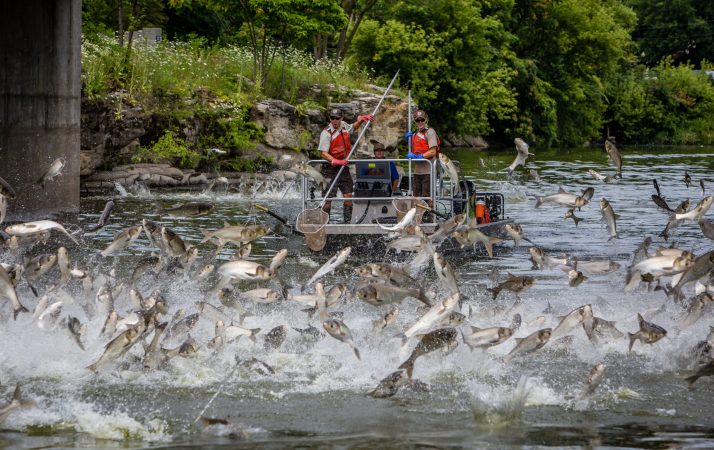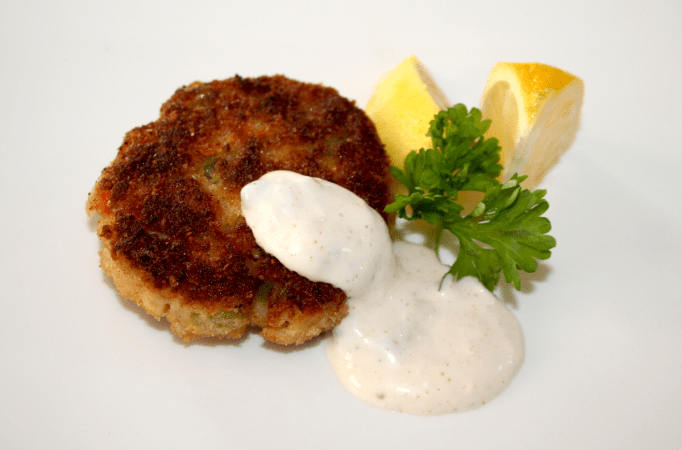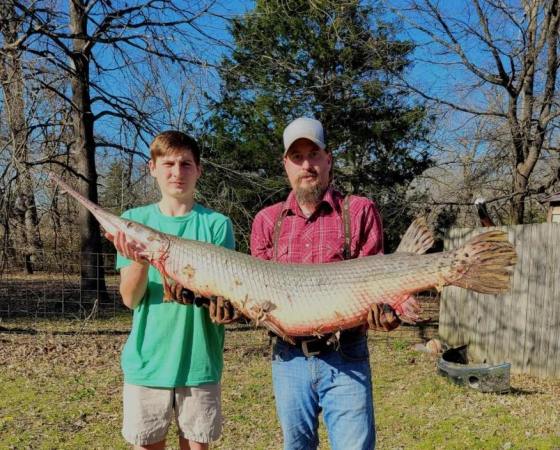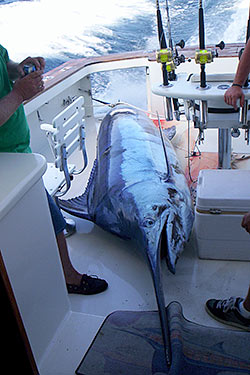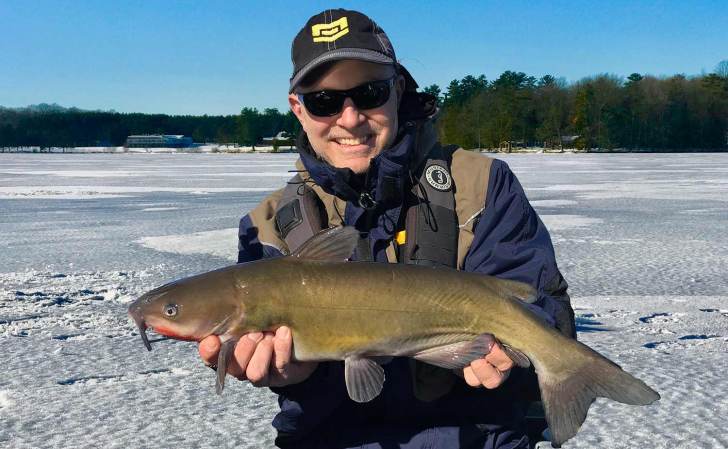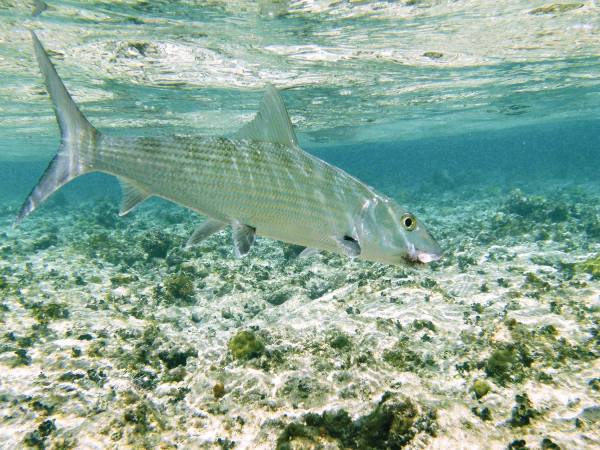It’s morbidly satisfying to watch silver carp being fed to a band saw. Especially the sound. The same bug-eyed fish known for jumping into boats and ruining riverine ecosystems are loaded onto a conveyor belt, where the high-speed blade slices them in two behind the gill plate. The body flops onto the next belt, while the head drops into a bin below. Both parts of the fish are marketable; In fact, save for the blood and slime, there’s not much waste here at Two Rivers Fisheries in Kentucky.
My station is the first spot on the line immediately following the saw. I’m wearing an ankle-length apron, rubber gloves, plastic sleeves, a hairnet, and a mask. Jim Burns is on my right; he’s the process foreman, and in the 10 minutes I’ve known him, he’s wavered between calling me “Greenhorn” and “Puddin’.” He rakes a headless carp off the belt and onto the stainless-steel cutting table in front of me and hands over a fillet knife, sharpened to the spine.
“You know what that is?” He points at the carp’s anal vent.
“Looks just like his butthole,” I say.
“You’re smarter than you look, Greenhorn. Run your knife up in there and cut up that seam on the belly to the fin. Pluck out that white thing—that’s the swim bladder—and throw it in that tub. Then you take this and get at the rest of the guts.”
The “this” he’s referring to is a horse brush.
“There’s no finer tool for taking the entrails out of a carp,” Burns says. With two whips of the brush, the guts fall to the floor, except the swim bladder, which joins an ever-growing pile of swim bladders in the plastic tote at my feet. He grabs a spray nozzle, rinses blood out of the fish, and sends the carp down the line. “Your turn, Greenhorn. Get to work.” I grab a carp and start cutting and am almost instantly heckled by the other workers on the production line.
“Got yourself a greenhorn there, Jim?” says one.
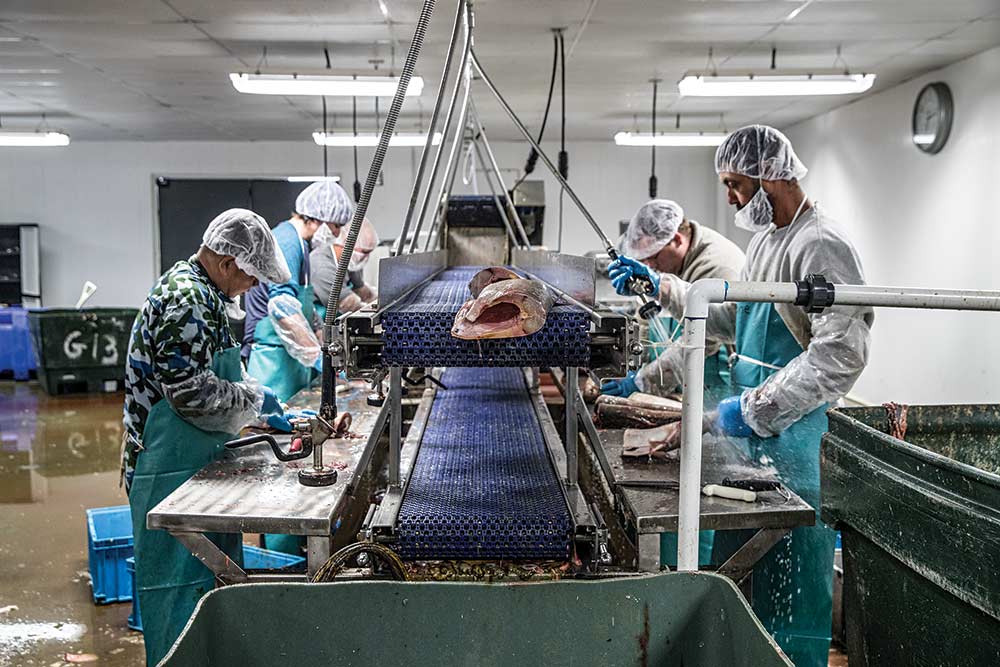
I’m the slowest on the line, but it’s not my first time gutting a fish either. I hold my own. The heckling doesn’t last long—and even if it did, it’s purely good-natured. Hell, I’m enjoying myself.
“This is really a great place to work, especially if you like to hear middle-aged men tell the same stories every day,” Burns says.
My bare ankles—I’m wearing Crocs, in contrast to everyone else’s rubber knee boots—are soaked with cold slime and blood. The room is refrigerated, and the just-cleaned fish are stacked on shelves behind us. Clean is what they are too. There’s mess associated with industrial fish processing, to be sure, but the fish on the racks could be on display in a fresh-seafood market.
“What happens to those?” I ask Burns. “More processing?”
“These are ready to freeze and ship,” he says. “Many of our customers want their fish whole.”
Customers. For silver carp. It’s hard to get my brain around it.
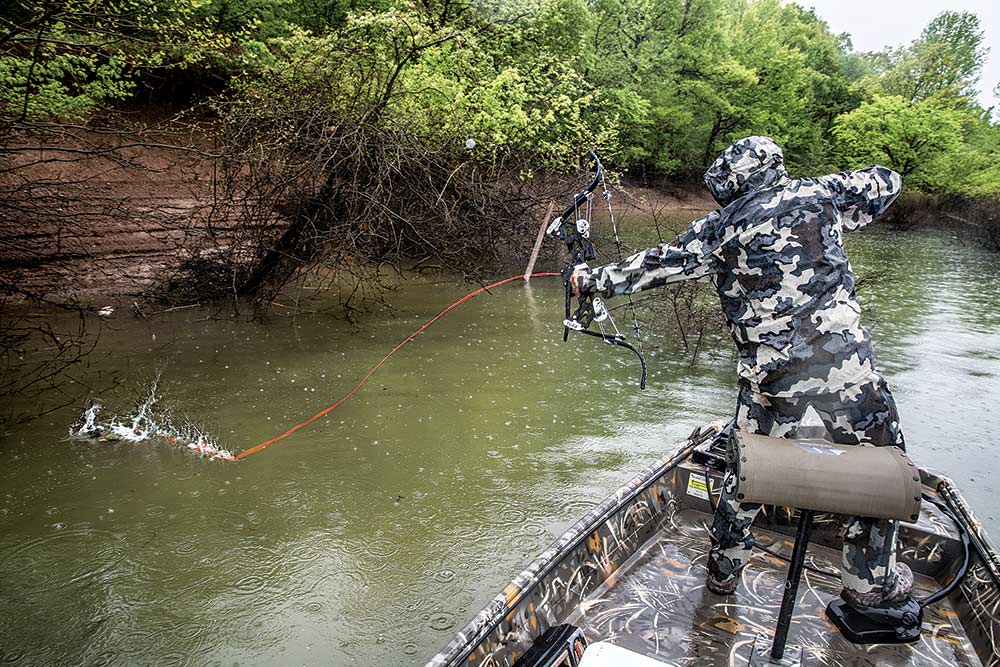
A Public Enemy
My dealings with Asian carp have mostly been from behind a bow. The backwaters of western Kentucky, near the confluence of the Mississippi, Ohio, Tennessee, and Cumberland rivers, are home. Historically, species like gar, drum, buffalo, and paddlefish were the targets for bowfishermen in this area. Today, we’re the epicenter of the Asian carp epidemic.
Silver, bighead, and grass carp were imported in the 1970s for phytoplankton control in Southern ponds. As the story goes, flooding allowed the fish to escape into the nearby warm rivers, which became the catalyst for an ecological disaster. Silver and bighead carp are filter feeders, meaning they eat the same plankton as the native baitfish.
The difference between a silver carp and a shad is that the carp will grow to weigh 5 pounds in a year and top out at 40. Females lay a million or more eggs per spawning cycle. Not only are they outcompeting native bait for food, but they’re also physically crowding out gamefish—bass, crappies, bream, catfish—from the available habitat.
Kentucky and Barkley lakes—reservoirs on the Tennessee and Cumberland rivers, respectively—have in the past been counted among the nation’s premier bass and crappie fisheries. But gamefish weights and numbers have been dwindling in the past few years, to the alarm of fisheries biologists, guides, and lifelong locals who’ve never known anything except world-class angling. Many believe carp are to blame.
Like other bowfishermen, I’ve tried eating the carp and have noted that, although bony, they taste just fine. Still, I mostly slough them off the arrow and into a tub, where they’re bound for fertilizer. On just about any hot summer day or night, you’ll tire of drawing a bow before you run out of silver carp targets.
We know we’re not putting a dent in the numbers, but when we run into bass fishermen on the river, we’re always met with a thumbs-up, a smile, and “kill ’em all because they’ve made the fishing suck” encouragement.
The local attitude is: We want them gone. And when it comes to fish dinners, well, they’re carp, not crappies.
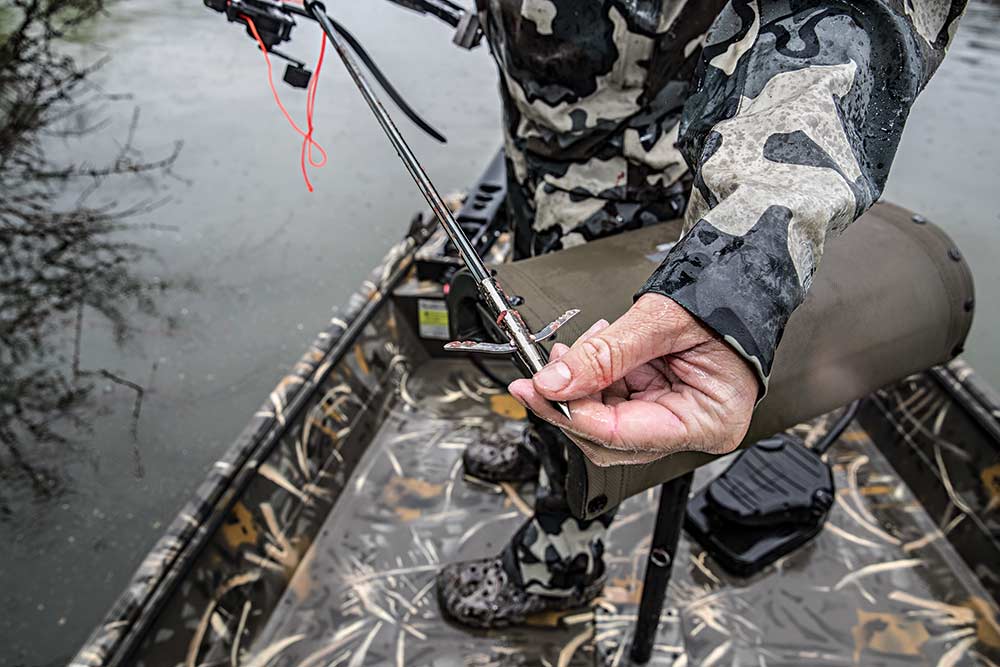
When Life Gives You Carp…
Fortunately, Angie Yu doesn’t see things that way. Yu was born in Heilongjiang Province, China, and later moved to Los Angeles. She was living in California working in the seafood import-export business when she heard about the South’s burgeoning carp problem, and so she traveled to Wickliffe, Ky., population 672, and spent her last dime investing in a processing facility called Two Rivers Fisheries, which opened in July 2012.
There aren’t many Asian carp processing facilities in the region—or anywhere in the U.S., for that matter. One in Grafton, Ill., that specialized in rendering fish oil and fish meal from carp was forced to shut down after residents complained of the smell.
But with Yu’s background in seafood exports, she saw an opportunity and the business has taken off. Now, she says, her biggest problem is getting enough of the carp under her processors’ knives to satisfy the overseas demand. She invites me for a tour of the facility and a hearty lunch—with various silver carp dishes on the menu.
I decide to take the day from start to finish: Hit a couple of my favorite bowfishing stops below the Kentucky Dam on the way to Wickliffe, and show up with a cooler full of my own carp. If the fish can be prepared in ways as delicious as Yu promises, I want to know how to clean and cook them myself.
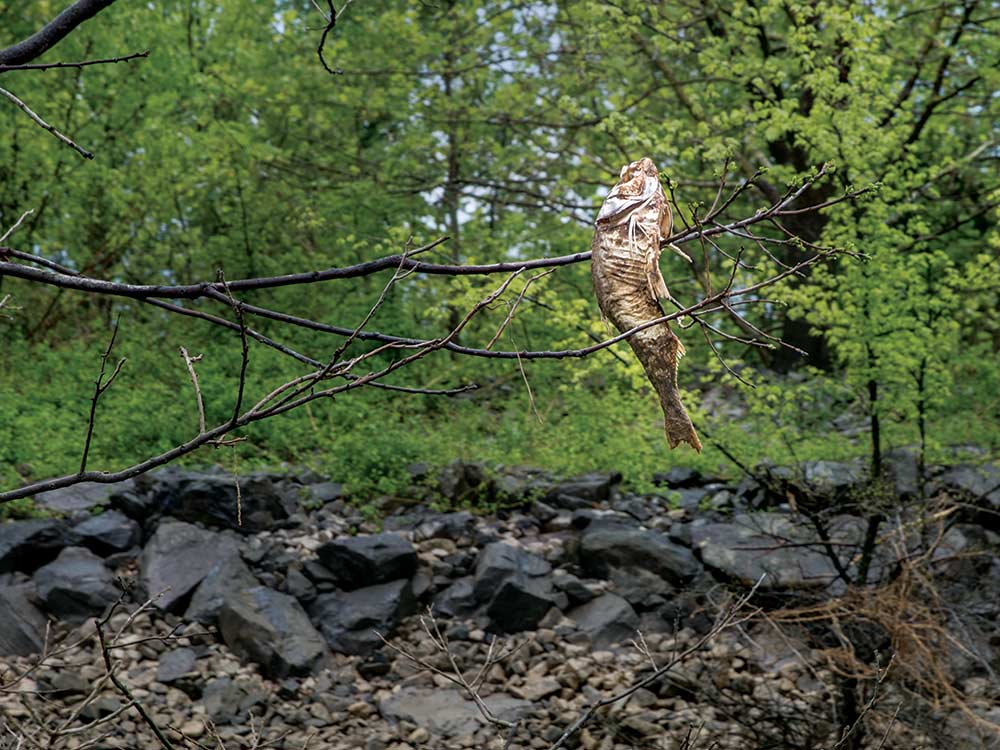
Of course, even for fish as pervasive as silver carp, fishing trips are never a guaranteed success. It’s been a late, wet, cold spring, and the tailwaters I normally shoot are a raging torrent. Downstream is likewise swift, high, and muddy.
Still, I drop my boat in for the first outing of the year. Navigating backwater sloughs and feeder creeks accessible only during high water, it’s evident the carp haven’t gone anywhere. Dead ones hang by the hundreds from limbs above my head. To make the scene a little more hellish, there’s a drowned and rotting pelican with its wings splayed in a willow. Hollis Bennett, my photographer, asks what killed the carp in the trees.
“Hell if I know for sure. Lots of ways for a carp to die down here,” I say.
The floodwater was tickling the canopy a few days ago, and the carcasses left in the limbs after it receded are an eerie reminder of a swollen river’s power—and just how many damned carp are swimming around here. I shoot a couple of small gar, and arrow a surfacing grass carp at the mouth of a feeder creek.
But the 10-minute hints of the sunshine I need to see with my polarized glasses are quickly overtaken by dark clouds and more rain. The fish are here—they’re boiling out of the shallows when I get my boat near the bank—but I can’t see them under these conditions. Summer is coming, and I know I’ll get more than my fill of carp killing soon enough. I trailer my boat and head to Wickliffe.
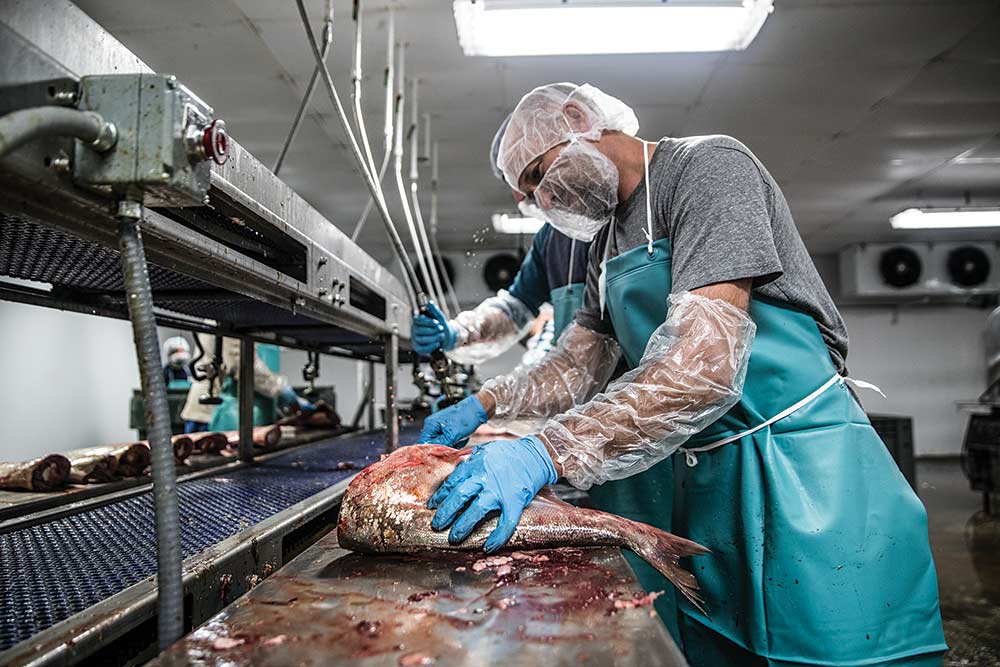
Lunchtime
After gutting a couple dozen carp, I realize that showing up without fish of my own is a minor concern—not that I’d have been able to clean them on the equipment anyway, due to food processing regulations.
“You be sure to spell my name right, Greenhorn,” Burns says. “It’s J-I-M. Not G-Y-M.”
I laugh and shake his hand, and continue my tour. After washing up, I find the test kitchen, where Yu, assistant manager Yuelun Warner, and operations manager Jeff Smith are busy cooking fish. I ask Yu when she first tried silver carp. She looks confused.
“When I was a little girl,” she says, tending a large skillet of sizzling, seasoned carp rib sections. “I grew up eating them because they’ve been an important food fish in China for centuries.”
“Some fishermen think there’s a trick to cleaning them, where you can get out all the bones. There’s just not,” Smith tells me. He’s dipping pieces of fish into a heavy batter. “We grind a lot of the fish, though, and the tiny bones are pulverized. That’s true for most commercially processed fish. Do you think the fillets for a fast-food sandwich come off the fish in perfect squares? It’s all ground. Silver carp is just as good as whitefish, tilapia, and the other stuff they’re using. It also has fewer calories per serving—and, of course, it’s much cheaper.”
I ask him about preparation of the whole fish we worked on in the processing room.
“Much of it is exported, and in China, nobody gives a second thought to picking around the bones,” he says. Smith spent nine days in China last year, learning as much as he could about the country’s fish-buying market.
“Their culture at mealtime is much different than ours. Americans are always in a hurry. We want a pile of boneless fillets and tartar sauce, and we want to eat as fast as we can. In China, friends and family sit down together for a meal, with a bunch of different dishes. They pass them around, and you sample and try things. No one minds nibbling around a few little bones.”
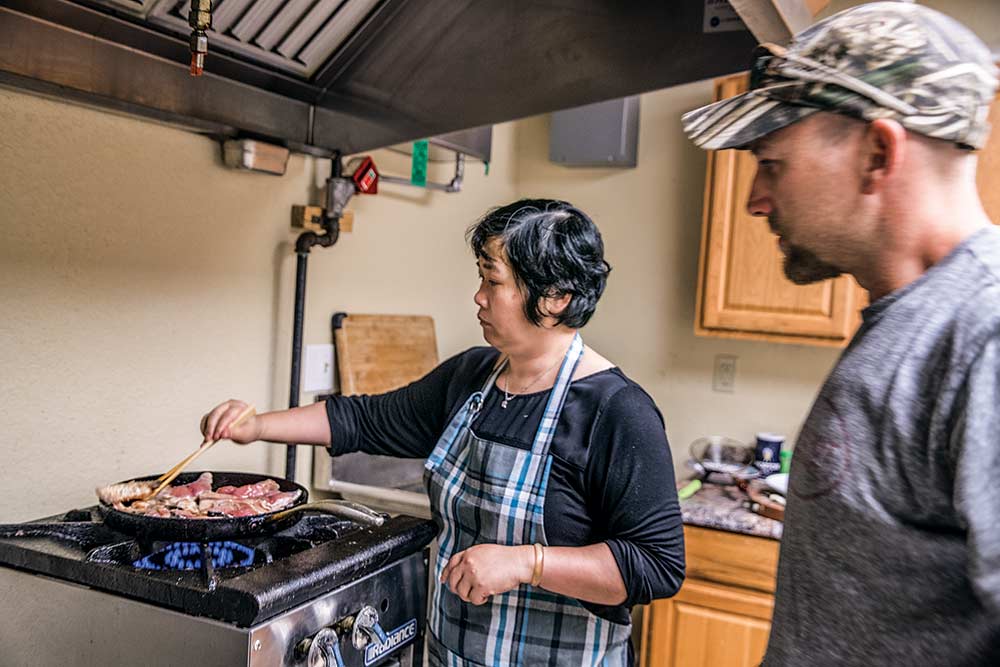
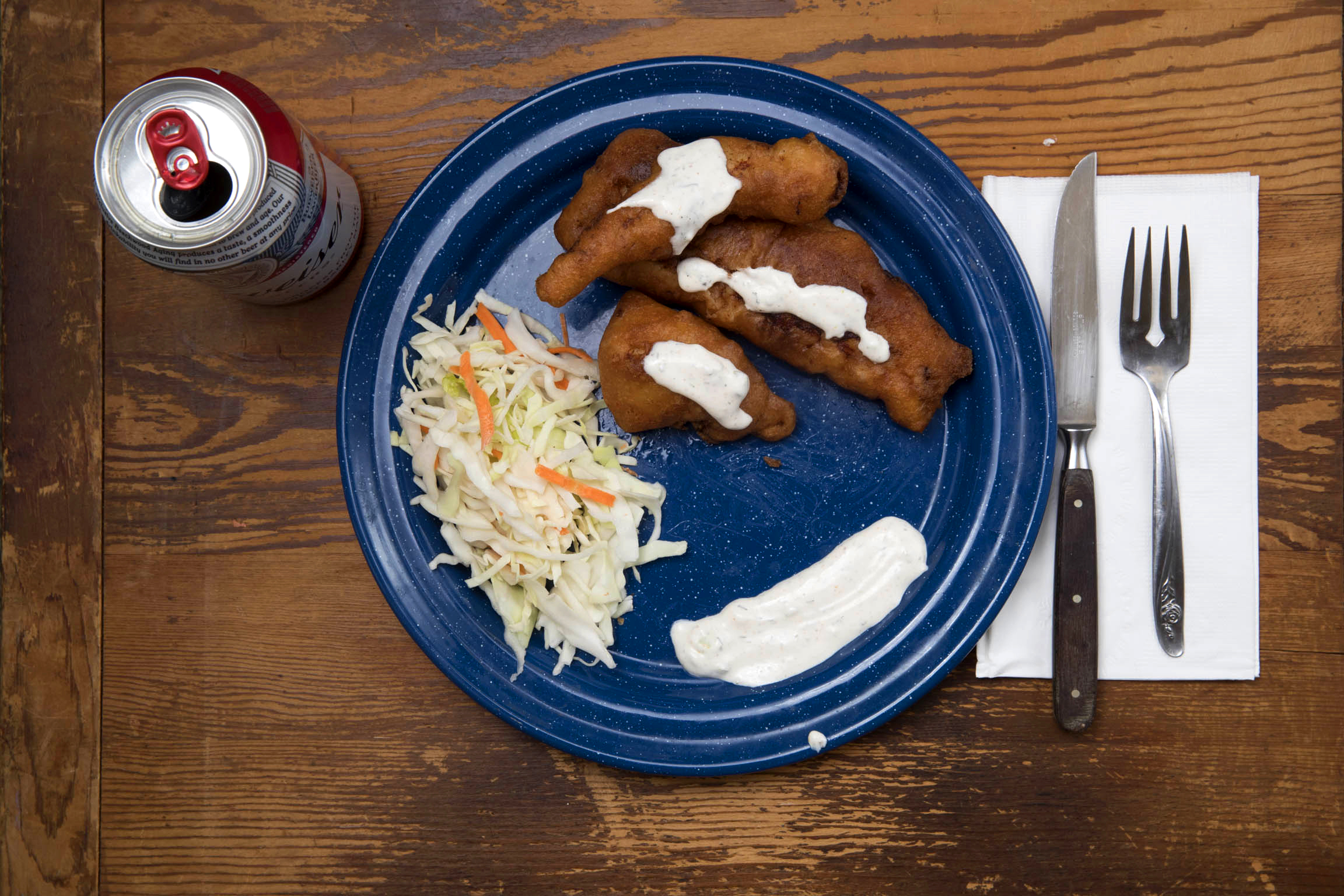
He drops a battered strip of carp into hot grease.
“I’m an old country boy, and I’ll eat anything,” he says. “I tried swim bladder soup. Didn’t have much flavor. Kind of chewy. But let me tell you, the fish recipes that Miss Angie cooks are delicious.”
I’m a country boy too, and I’d guess fried fish is atop the list of my favorite meals. Smith’s recipe, with a thick fish-and-chips-style batter, is really good. But Yu hands me a plate of the sautéed ribs, with a side of dumplings and wontons, and a spicy dipping sauce. I fumble with chopsticks for a minute before she smiles: “You can use a fork.” I do one better and dig in with my fingers. It’s absolutely delicious—and I can’t help but think about all those bowfished carp I’ve chunked into the fertilizer pile over the years.
Seeing Green
We watch a couple of truckloads of carp being unloaded from commercial anglers’ trucks at the docking station. The fishermen are caked in slime—but that doesn’t bother them as they watch the scales. Silver carp pay 17 cents per pound, bigheads 18 cents, and grass carp 22 cents.
“One of our big problems is getting enough fishermen,” Smith tells me. “We take fish from up to five hours away. We have guys bringing in carp from Missouri and Tennessee. It’s hard work and requires some equipment up front. But we had a couple fishermen make $100,000 last year.”
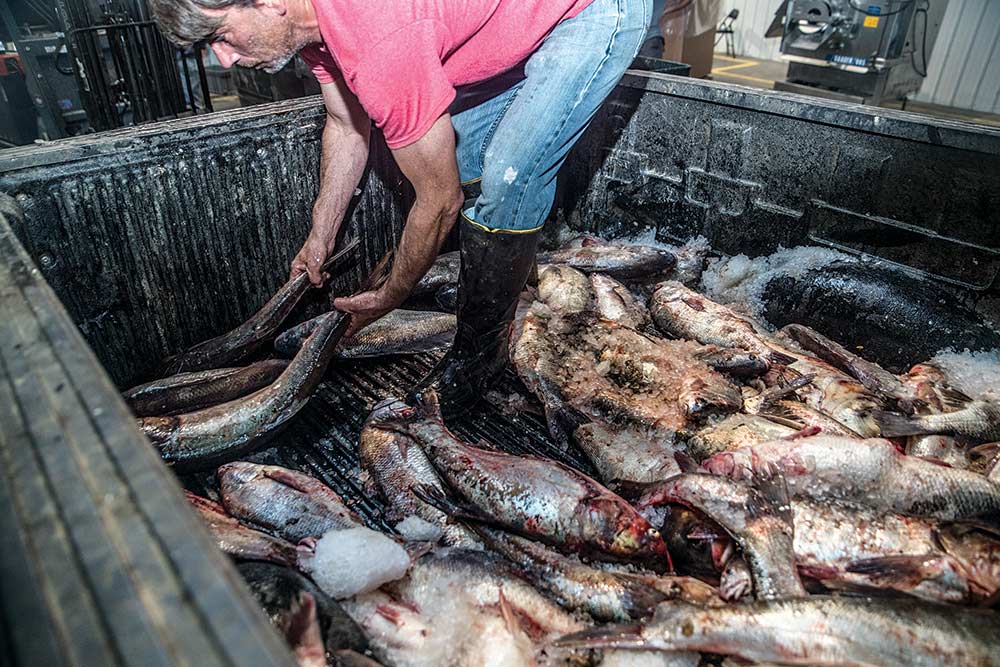
There’s big money tied to the commercial harvest of invasive carp. And maybe there is no solution for ridding the waterways of these fish and restoring the recreational angling to what it once was. But this business is the spearhead of the best management option I’ve seen yet. Many recreational anglers still recoil at the idea of commercial fishing, but Smith believes the spotlight bowfishermen in particular are putting on Asian carp is helping the cause. For whatever reason, folks with baitcasters and nets alike seem to identify with skewering carp on fiberglass arrows.
Read Next: 7 Tips for Better Bowfishing
“I can’t accept fish shot with a bow for food production, but we are working on a fertilizer-production facility right now,” Smith says. “There’s money in fish fertilizer too—and we’ll be able to take fish from bowfishermen for that.”
Certainly, normalizing carp as an eater fish in the States would be a huge step in getting more commercial fishermen to target Asian carp. Yu notes that many of her Chinese customers are enamored with the idea of shooting jumping carp with a bow and arrow too—to the point of requesting guided bowfishing trips when they visit the U.S.
With all of those pieces in place, surely the landscape of carp fishing is shifting in a new direction. Lord knows we have plenty of carp to meet the demand.
Angie Yu’s Spicy Silver Carp Recipe
Ingredients
Whole, bone-in carp rib sections
Olive oil
Salt
Soy sauce
Cooking wine
Scallions
Red chili peppers, sliced
Ginger, minced (preferably fresh)
Garlic, minced
Pinch of sugar
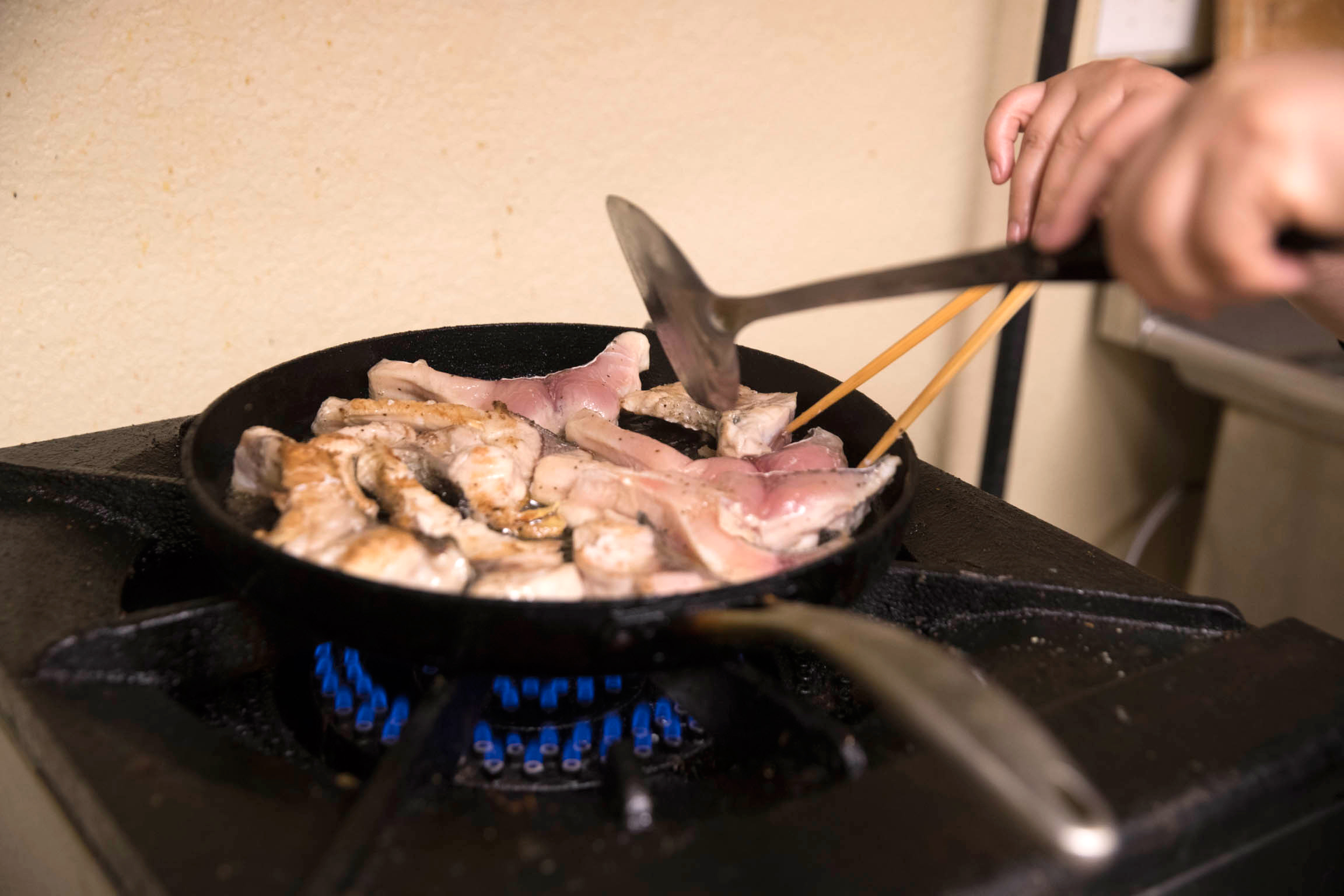
Directions
Heat the olive oil in a sauce pan, and combine all the ingredients except the carp into a sauce. Season to taste, then roll the ribs in the sauce and sautée on both sides until the fish flakes apart.
